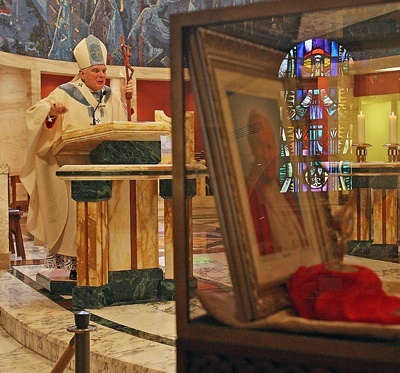By Communications Department - Archdiocese of Miami
Homily preached by Archbishop Thomas Wenski at St. Mary Cathedral on Sept. 9, 2012, during a Mass marking the 25th anniversary of Pope John Paul II's visit to South Florida, which took place Sept. 10-11, 1987.
September 10-11 will mark the 25th anniversary of Pope John Paul II's visit to Miami. Those two days with (and the days, the weeks, the months that many of you who are here today devoted to preparing for this visit) were also for us here in South Florida an Amazing Grace. Today, we welcome Msgr. Jude ODoherty, whom Archbishop McCarthy chose to lead the committee in charge of the papal visit. He was assisted by Fathers Ken Whitaker and Dan Kubala who also are here today and you can imagine the complexities of providing for the security not only for the Pope but for a President; in all this the committee was ably assisted by Major Dean DeJong of the Miami Police Department who is also present at this Mass this morning.
This Miami visit - his fourth to the United States as Pope - was memorable for his meeting with President Ronald Reagan at Viscaya and for his historic meeting with Jewish leaders from all over the United States at Miami's downtown fine arts center, not to mention the outdoor Mass on FIU's Tamiami campus cut short because of a powerful (but typically South Florida) thunderstorm that while not dampening the enthusiasm of the thousands in attendance did leave all soaked and wet.
He also visited here and after praying before the Blessed Sacrament and speaking to the congregation, the Holy Father stepped outside to address scores of Haitians in their native Creole language. And he also addressed representatives of U.S. priests at St. Martha's Church in Miami Shores (where I had to opportunity to grasp his hand and give him a quick greeting in Polish).

Photographer: MARLENE QUARONI | FC
Archbishop Thomas Wenski preaches the homily as a photo of Pope John Paul II and a blood relic are displayed in the foreground.
By fearlessly preaching the Gospel, in season and out of season, he embraced the world convinced that the Church would be faithful to her mission neither by fleeing from the world nor by surrendering to it but through engagement with the world. His was the path of dialogue. The Church, he was convinced, had something to say, a Word to share. And that Word was Jesus Christ. His legacy of clear and confident teachings will continue to enrich and inspire the Church for centuries to come. His constant exhortation, Be not afraid, has inspired Catholics everywhere, especially the young, to put out into the deep and embark on a New Evangelization in a stormy and uncertain world.
A man of many gifts, John Paul II brought to the papacy great human qualities and profound spiritual virtues. He was an intellectual who nevertheless could preach with the common touch of a parish priest. He was a man of great discipline, and in his later years he exercised almost superhuman control of a frail and sick body to continue his mission and to be present to his flock. He was also a man of prayer, able to summon deep powers of concentration and recollection in order to contemplatively and mystically commune with God.
In his ministry as Pope, he embraced the Second Vatican Council's renewed emphasis on the universal call to holiness. Throughout his 26 years as Pope, he never tired of placing before us the radical demands of the Gospel and he urged us not to be afraid to embrace them. By exhortation but also by example, an example given even with much pain and suffering, he reminded us that for a Christian it would be a contradiction to settle for a life of mediocrity, marked by a minimalist ethic and a shallow religiosity. By his words but also by his example, he taught us that a Christian cannot fail to listen to Christ; nor should he or she fail to speak of Christ.
He canonized more saints than any Pope in history to underscore the fact that it is holiness which expresses best the mystery of the Church. Holiness is, he taught us, a message that convinces without need for words and is a living reflection of the face of Christ. John Paul II, in his word and in his life, gave us a message that is convincing, a message of hope, a message about Jesus Christ, the source of our hope, the hope that does not disappoint.
We believe that at Mass we worship God in the presence of all the angels and saints; but at the same time, isn't an amazing grace for us to remember that in this very cathedral where we now worship two who have been raised to the altars also prayed here: Blessed Pope John Paul II and Blessed Mother Teresa of Calcutta?
Christ is the one who has done all things well, as the people acclaimed upon witnessing the cure of the deaf mute. But, those whom we look up to as saints made Christ their model in all things. Once, in catechism class, a little child was asked what is a saint? In a perfect illustration of that phrase "from the mouths of babes," he replied a bit hesitantly: "A saint is a - uh - window." His experience of saints was of those depicted in the stained glass windows of his parish church. But he had grasped a profound truth. Saints are indeed like windows: through them light shines, not the light of the sun but the light of the Son.
And in Karol Wojtyla, that light shone brightly! As he once looked out on the multitudes from his window at the Vatican or from the many altars in the countries he visited, he now looks down from heaven's window. And, we can say that he himself is a window through which the light of Christ continues to shine on us.
In his youth, Karol Wojtyla was an athlete and a sports enthusiast. It would be curious to know what he thought of the new extreme sports now popularized on T.V.: extreme golf, extreme skiing, etc. As one pundit said: This Polish Pope invented a new sport: Extreme holiness. But for John Paul II, holiness was not just a pastime; it was the pursuit of his life. And it should be ours as well.
He canonized more saints than any Pope in history to underscore the fact that it is holiness which expresses best the mystery of the Church. Holiness is, he taught us, a message that convinces without need for words and is a living reflection of the face of Christ. John Paul II, in his word and in his life, gave us a message that is convincing, a message of hope, a message about Jesus Christ, the source of our hope, the hope that does not disappoint.
We believe that at Mass we worship God in the presence of all the angels and saints; but at the same time, isn't an amazing grace for us to remember that in this very cathedral where we now worship two who have been raised to the altars also prayed here: Blessed Pope John Paul II and Blessed Mother Teresa of Calcutta?
Christ is the one who has done all things well, as the people acclaimed upon witnessing the cure of the deaf mute. But, those whom we look up to as saints made Christ their model in all things. Once, in catechism class, a little child was asked what is a saint? In a perfect illustration of that phrase "from the mouths of babes," he replied a bit hesitantly: "A saint is a - uh - window." His experience of saints was of those depicted in the stained glass windows of his parish church. But he had grasped a profound truth. Saints are indeed like windows: through them light shines, not the light of the sun but the light of the Son.
And in Karol Wojtyla, that light shone brightly! As he once looked out on the multitudes from his window at the Vatican or from the many altars in the countries he visited, he now looks down from heaven's window. And, we can say that he himself is a window through which the light of Christ continues to shine on us.
In his youth, Karol Wojtyla was an athlete and a sports enthusiast. It would be curious to know what he thought of the new extreme sports now popularized on T.V.: extreme golf, extreme skiing, etc. As one pundit said: This Polish Pope invented a new sport: Extreme holiness. But for John Paul II, holiness was not just a pastime; it was the pursuit of his life. And it should be ours as well.

